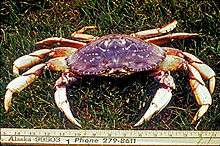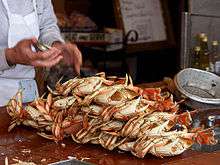Dungeness crab
The Dungeness crab, Metacarcinus magister (the naming convention recognised by WoRMS) or Cancer magister (the naming convention recognised by ITIS), is a species of crab that inhabits eelgrass beds and water bottoms on the west coast of North America. It typically grows to 20 cm (7.9 in) across the carapace and is a popular seafood. Its common name comes from the port of Dungeness, Washington, where it is "a prized crustacean that supports the most valuable fishery on the west coast", and where ocean acidification threatens the marine environment.[2]
| Dungeness crab | |
|---|---|
 | |
| Dungeness crab measuring 17 cm (6.7 in) | |
| Scientific classification | |
| Kingdom: | |
| Phylum: | |
| Subphylum: | |
| Class: | |
| Order: | |
| Infraorder: | |
| Family: | |
| Genus: | |
| Species: | M. magister |
| Binomial name | |
| Metacarcinus magister | |
| Synonyms | |
|
Cancer magister Dana, 1852 [1] | |
Description
The carapace widths of mature Dungeness crabs may reach 25 centimetres (9.8 in) in some areas off the coast of Washington, but are typically under 20 cm (7.9 in).[3] They are a popular delicacy, and are the most commercially important crab in the Pacific Northwest, as well as the western states generally.[4] The annual Dungeness Crab and Seafood Festival is held in Port Angeles, Washington each October.[5]
Dungeness crabs have a wide, long, hard shell, which they must periodically moult to grow; this process is called ecdysis. They have five pairs of legs, which are similarly armoured, the foremost pair of which ends in claws the crab uses both as defense and to tear apart large food items. The crab uses its smaller appendages to pass the food particles into its mouth. Once inside the crab's stomach, food is further digested by the "gastric mill", a collection of tooth-like structures. M. magister prefers to eat clams, other crustaceans and small fish, but is also an effective scavenger. Dungeness crabs can bury themselves completely in the sand if threatened.
Life cycle and ecology
Mature female crabs generally molt between May and August, and mating occurs immediately after the female has molted and before the new exoskeleton hardens.[6] Males are attracted to potential mates by pheromones present in the urine of females. Upon locating an available female, the male initiates a protective premating embrace that lasts for several days. In this embrace, the female is tucked underneath the male, oriented such that their abdomens touch and their heads face each other. Mating occurs only after the female has molted, and the female signals her readiness to molt by urinating on or near the antennae of the male. The female extrudes the eggs from her body several months later; however, they remain attached under her abdomen for three to five months until they hatch. Young crabs are free-swimming after hatching, and go through five larval stages before reaching maturity after about 10 molts or two years.
Juvenile crabs develop in eelgrass beds and estuaries where salinity levels tend to be low. The hyposaline conditions of the estuaries are lethal to some of the crab's symbionts, such as Carcinonemertes errans which consumes a brooding female's live eggs. Dungeness crabs surveyed in Coos Bay were less likely to be infected by C. errans and have fewer worms present on their carapace when inhabiting less saline waters farther inland.[7]
Distribution
The Dungeness crab is named after Dungeness, Washington,[8] which is located approximately 5 miles (8.0 km) north of Sequim and 15 miles (24 km) east of Port Angeles. Its typical range extends from Alaska's Aleutian Islands to Point Conception, near Santa Barbara, California,[9] while it is occasionally found as far south as Magdalena Bay, Baja California Sur, Mexico.[10]
A genetic analysis of adult Dungeness crabs indicated that there is one population across the California Current System, but it is likely that interannual variation in physical oceanographic conditions (such as ocean circulation patterns) influence larval recruitment among regions, causing genetic diversity to change through time.[11]
Culinary use

The Dungeness crab is considered a delicacy in the United States and Canada.[12] [13] Long before the area was settled by Europeans, Native American tribes throughout the crustacean's range had the crab as a traditional part of their diet and harvested them every year at low tide.[14]The flesh has what is considered to be a delicate flavour and slightly sweet taste.[15] Today they are an integral part of the cuisines of California, British Columbia, and the Pacific Northwest and traditionally feature in dishes like Crab Louie or Cioppino.
About one-quarter of the crab's weight is meat.[16] Dungeness crabs can typically be purchased either live or cooked. Live crabs are cooked simply by dropping them into boiling salt water, waiting for a boil to return, and then allowing it to continue for 15 minutes, after which time the crabs are removed and placed into cold water to cool, and then cleaned. Another method of preparing crab is called half backing. Half backing is done by flipping the crab upside down and chopping it in half (from head to "tail"), after which the guts and gills can be scooped or hosed out. Many consider half backing to be superior to cooking the entire crab, because the meat is not contaminated by the flavor or toxins of the guts. Furthermore, half backed crabs boil faster or can be quickly steamed instead of boiled. Two common tools for removing crab meat from the shell are a crab cracker and a shrimp fork. Sometimes, a cleaver, mallet, or small hammer is used for cracking Dungeness crab, but the use of these devices is not recommended, as the integrity of the meat may be compromised due to the impact.[17]
Sustainability
Seafood Watch has given the Dungeness crab a sustainable seafood rating of 'Good Alternative' to overfished species or fish that is farmed in ways that harm other marine life or the environment.[18] In 2014, 53 million pounds worth $170 million was harvested.[19]
A 2020 study funded by NOAA showed that larval crabs are being affected by ocean acidification caused by lowered pH levels resulting in a higher concentration of hydrogen ions.[2]
"State crustacean" designation in Oregon
In 2009, based on lobbying from schoolchildren at Sunset Primary School in West Linn, Oregon, and citing its importance to the Oregon economy, the Oregon Legislative Assembly designated the Dungeness crab as the state crustacean of Oregon.[20]
References
- Peter K. L. Ng, Danièle Guinot & Peter J. F. Davie (2008). "Systema Brachyurorum: Part I. An annotated checklist of extant Brachyuran crabs of the world" (PDF). Raffles Bulletin of Zoology. 17: 1–286. Archived from the original (PDF) on 2011-06-06.
- "Pacific Ocean now so acidic that it's dissolving shells of Dungeness crabs, study finds" Scripps, Jan 29, 2020.
- "2006-2007 Fishing in Washington Rule Pamphlet" (PDF). Washington Department of Fish and Wildlife. p. 130. Archived from the original (PDF) on June 17, 2009.
- "Species Fact Sheet. Cancer magister Dana, 1852". FAO. January 22, 2004.
- "Dungeness Crab and Seafood Festival".
- "Dungeness Crab Biology". Fisheries and Oceans Canada. Retrieved April 20, 2011.
- Dunn, Paul H.; Young, Craig M. (2013-12-20). "Finding refuge: The estuarine distribution of the nemertean egg predator Carcinonemertes errans on the Dungeness crab, Cancer magister". Estuarine, Coastal and Shelf Science. 135: 201–208. doi:10.1016/j.ecss.2013.10.012.
- "The Dungeness Crab". Dungeness community website. Retrieved August 28, 2006.
- "Seafood Watch Dungeness Crab Report" (PDF). Monterey Bay Aquarium. Archived from the original (PDF) on July 22, 2012. Retrieved June 10, 2010.
- "Dungeness Crab of California and Its Close Relatives". California Department of Fish and Wildlife. Retrieved August 30, 2015.
- Jackson, Tyler M.; Roegner, G. Curtis; O'Malley, Kathleen G. (2018). "Evidence for interannual variation in genetic structure of Dungeness crab (Cancer magister) along the California Current System". Molecular Ecology. 27 (2): 352–368. doi:10.1111/mec.14443.
- https://www.sea2table.com/blog/tales-from-the-dock/dungeness-crab-season-in-full-swing/
- https://www.foodnetwork.ca/shows/great-canadian-cookbook/photos/must-try-british-columbia-recipes/#!ultimate-nanaimo-bar
- http://traditionalanimalfoods.org/marine-invertebrates/crustaceans/page.aspx?id=6518#dung-b
- Gary Rainer Puetz (2008). Cooking with the Seafood Steward. Arnica Publishing. ISBN 978-0-9801942-5-8.
- Saekel, Karola (November 18, 1998). "For Bay Area Crab Lovers, The Boats Are Coming In". San Francisco Chronicle. Retrieved October 7, 2008.
- "Online video teaching how to crack and clean Dungeness crab". Archived from the original on 2011-07-07. Retrieved 2006-12-23.
- "Seafood Recommendations: Dungeness Crab". Seafood WATCH. Retrieved March 4, 2016.
- "Dungeness Crab Report 2014" (PDF). Pacific States Marine Fisheries Commission. Retrieved November 6, 2015.
- "House Joint Resolution 37, 2009 (Enrolled)". Oregon State Legislature. Archived from the original on June 11, 2011. Retrieved October 23, 2009.
Further reading
| Wikimedia Commons has media related to Metacarcinus magister. |
- Dixon, Kirsten (2003). The Winterlake Lodge Cookbook: Culinary Adventures in the Wilderness. Anchorage, AK: Alaska Northwest Books. ISBN 978-0-88240-562-9. OCLC 51855528.
- Hibler, Jane (1991). Dungeness Crabs and Blackberry Cobblers: the Northwest Heritage Cookbook. New York, NY: Knopf. ISBN 978-0-394-57745-6. OCLC 24430394.
- Dana Point Fish Company - Top and Bottom Views of Dungeness Crab
